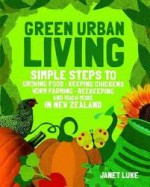Official Kiwi Families review by Emma Bassett
The set up:
Janet Luke champions having your own urban Eden, stacked full of novel ideas to get you into your garden. It’s kept accessible and littered with honest and helpful tips throughout. There are simple steps for everyone whether you’re in an inner city apartment with a miniscule balcony or have acres to explore.
I’m liking:
You can start with keeping herbs alive, kids having their own vege patches and being paid per snail for bounty, or embracing the lot with fruit+vegetable planting and micro-livestock. It’s also sustainable in it’s truest sense. Channelling her Scottish heritage, she encourages reusing anything and everything, foraging for materials (including building simple structures, from all manner of plant boxes through to ecosystems for worms, bees and chickens). You’ll be rewarded with armfuls of fresh produce and the satisfaction of giving back a little.
Things that made me go hmmm:
There’s only so much you can do in the city so it could be better suited to being Green sub-Urban Living or Gardening- even then, she works around this with some unique ideas to built within small spaces (like a herb ladder). But if you have a patch of green, it’s a great way to keep the kids fascinated and loving the outdoors as a family.
Extra for experts:
This is the beauty of this book. You could work through every idea and chapter, and be kept going on the inspiration for years.
Conclusions:
This book could well set you up to be self sustainable over time. More than that though, it makes you want to be. It’s engaging, interesting and makes you think more about how you can be the change and make a difference on a local level.



1 Comment
Official Kiwi Families review by Emma Bassett
The set up:Janet Luke champions having your own urban Eden, stacked full of novel
ideas to get you into your garden. It’s kept accessible and littered
with honest and helpful tips throughout. There are simple steps for
everyone whether you’re in an inner city apartment with a miniscule
balcony or have acres to explore.
I’m liking: You can start with keeping herbs alive, kids having their own vege
patches and being paid per snail for bounty, or embracing the lot with
fruit+vegetable planting and micro-livestock. It’s also sustainable in
it’s truest sense. Channelling her Scottish heritage, she encourages
reusing anything and everything, foraging for materials (including
building simple structures, from all manner of plant boxes through to
ecosystems for worms, bees and chickens). You’ll be rewarded with
armfuls of fresh produce and the satisfaction of giving back a little.
Things that made me go hmmm: There’s only so much you can do in the city so it could be better suited
to being Green sub-Urban Living or Gardening- even then, she works
around this with some unique ideas to built within small spaces (like a
herb ladder). But if you have a patch of green, it’s a great way to keep
the kids fascinated and loving the outdoors as a family.
Extra for experts: This is the beauty of this book. You could work through every idea and chapter, and be kept going on the inspiration for years.
Conclusions: This book could well set you up to be self sustainable over time. More
than that though, it makes you want to be. It’s engaging, interesting
and makes you think more about how you can be the change and make a
difference on a local level.